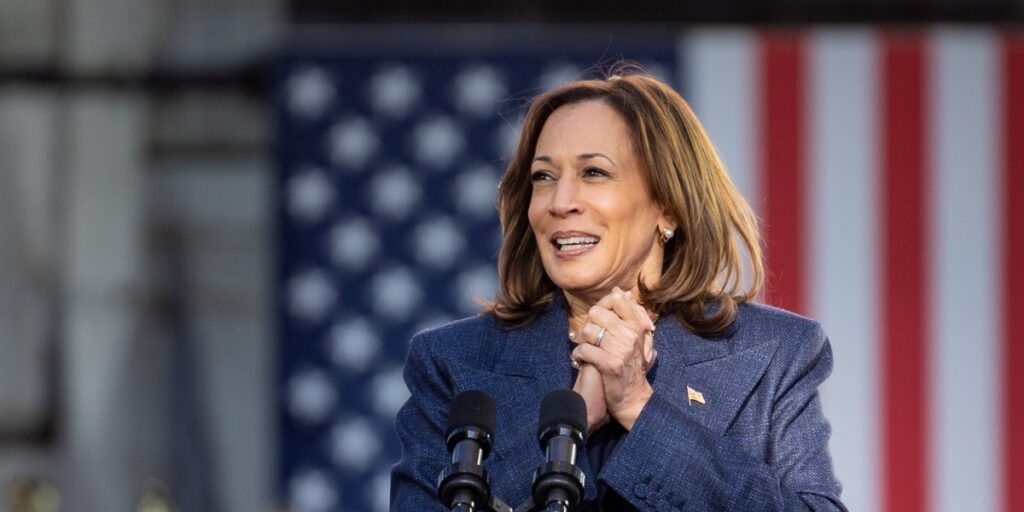[ad_1]

With three weeks left in the presidential campaign, Democrat Kamala Harris is spending most of her days trying to shore up support in the “blue wall” states of Pennsylvania, Michigan and Wisconsin as she tries to avoid a repeat of Hillary Clinton’s collapse there eight years ago.
The vice president campaigned at a hockey rink on Monday in Erie, Pennsylvania, where she denounced Republican candidate Donald Trump as “unhinged.” She visited an art gallery in Detroit with actors Don Cheadle, Delroy Lindo and Cornelius Smith. Jr. on Tuesday, then recorded a radio town hall with Charlamagne tha God.
On Wednesday, Harris was back in Pennsylvania to stress allegiance to the Constitution as she stood just steps from the banks of the Delaware River, where George Washington crossed with his troops in a pivotal moment of the Revolutionary War.
Her pace doesn’t let up for the rest of the week. Harris is expected to hold three events in Wisconsin on Thursday, including a meet-and-greet with students at the University of Wisconsin-Milwaukee, and three more in Michigan on Friday. She then campaigns in Detroit on Saturday.
A loss anywhere in the “blue wall,” a name that reflects the region’s traditional Democratic leaning, could doom Harris’ path to the presidency.
“You don’t take those states for granted. And she’s not,” said Joel Benenson, a Democratic pollster.
He previously served as chief strategist for Clinton, whose campaign was so overconfident that it stopped conducting its own polls in Midwest battlegrounds as the election approached.
“We’ve got a painful lesson in 2016 when we didn’t go to the ‘blue wall’ states, and we lost,” Benenson said.
Harris’ campaign emphasized that she’s not giving up on Sun Belt battlegrounds like North Carolina, Georgia, Arizona and Nevada. The vice president was in North Carolina over the weekend and she’s expected to be back in Georgia on Sunday.
But any candidate’s most precious resource is time, and Harris’ schedule reflects the consensus about her most likely shot at winning the White House.
“It’s not the only path, but it’s the easiest path to victory,” said Democratic pollster Celinda Lake.
She added, “If you can’t win Pennsylvania or Michigan, do you really think you can win Georgia or North Carolina?”
Pennsylvania and Michigan are Harris’ most popular destinations since Labor Day, with eight stops in each state, according to an Associated Press tracking of candidates’ public events.
At Harris’ event in Washington Crossing on Wednesday, one voter said Democrats had discovered the cost of complacency the hard way.
“In 2016, we thought we had it, you know, we thought we were okay,” said Melanie Woods, a retired school principal who came all the way from Brooklyn. “And I don’t think you can ever take anything for granted any more.”
Dan Kanninen, the Harris campaign’s battleground states director, said the vice president has “multiple pathways” to win.
“All seven battleground states are in play, and we know each will be incredibly close,” he said. “That is why we will continue to engage and mobilize voters aggressively across all these states until Election Day.”
During her campaign travels, Harris is trying to pick strategic areas to talk about key policies, such as promoting auto jobs and union membership in Detroit and going to Douglas, Arizona to unveil plans to tighten rules for immigrants seeking asylum at the U.S.-Mexico border after she walked along the towering wall separating the two countries.
The campaign is also increasingly relying on large organizational networks in key states, including coordinated offices with state Democratic parties, to fill in the gaps when Harris isn’t there. It’s deploying key surrogates — most notably Harris’ running mate, Minnesota Gov. Tim Walz — to lessen the impact of choosing to travel to one part of the country versus the other.
Democrats have other benefits, too. There’s a deep bench of high-profile politicians who are united behind Harris, including former President Barack Obama, who has been making campaign stops on her behalf. And there’s a campaign war chest larger than Trump’s, allowing Harris to keep up the pressure with advertising and expansive get-out-the-vote efforts.
Democrats’ electoral odds have ebbed and flowed during this tumultuous election year. President Joe Biden had faced a dwindling path to reelection, with some purple states sliding out of reach. But when he dropped out of the race in July, Harris’ team emphasized her potentially broader geographic appeal.
“Vice President Harris enters a tight race, but it is clear that she can bring together a coalition of voters to keep a wide set of states in play,” Campaign Chair Jen O’Malley Dillon wrote in a memo in late July.
But that doesn’t mean that some states aren’t more important than others.
“You win Pennsylvania, and you’re the next president,” Sen. John Fetterman said at Harris’ rally in Erie.
Trump’s travel is less tightly focused than Harris’ this week. He was in Pennsylvania on Monday, Illinois and Georgia on Tuesday and Florida on Wednesday.
He attends the Al Smith charity dinner in New York on Thursday and returns to Detroit on Friday
His previous visit there generated backlash because he criticized the city, which is rebounding after years of financial problems.
“Our whole country will end up being like Detroit if she’s your president,” Trump said during a speech to the Detroit Economic Club.
Tommey Walker, founder and owner of the clothing company Detroit vs. Everybody, derided Trump for disparaging his city while introducing Harris at an event on Tuesday.
“Now it’s Detroit versus Donald Trump,” Walker proclaimed.
Harris, by contrast, talked about the city in reverent tones. She recalled making friends with students from Detroit while attending Howard University.
“I just feel a kindred spirit whenever I come to Detroit,” Harris said.
[ad_2]
Source link
